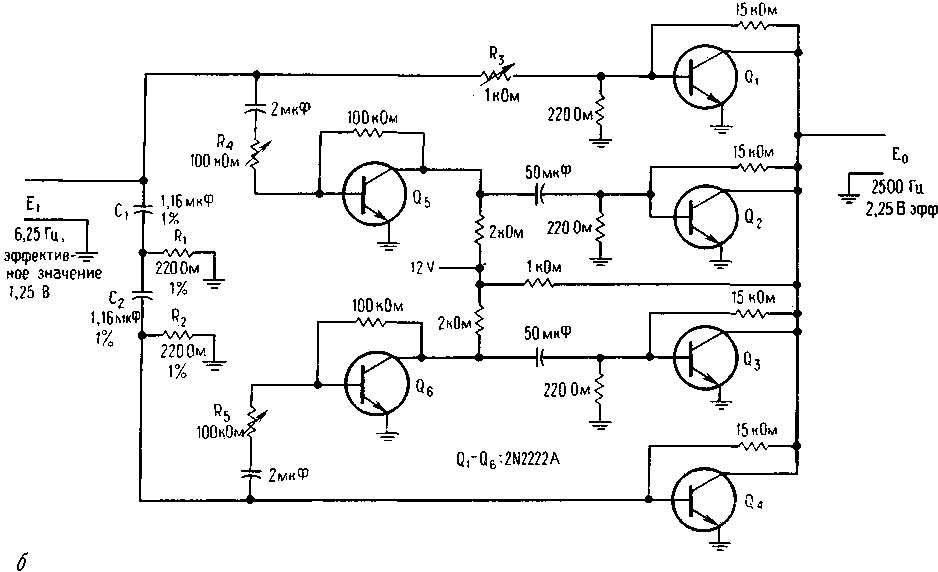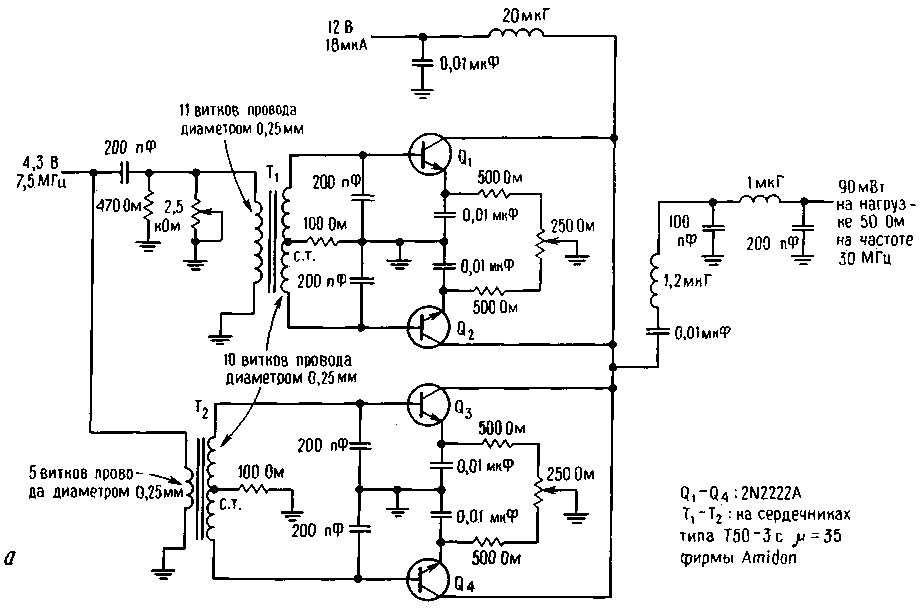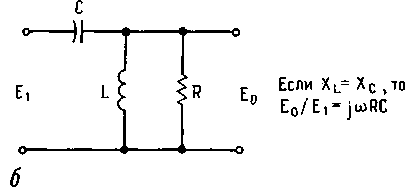Frequency multiplier on phase shifters. Encyclopedia of radio electronics and electrical engineering

Encyclopedia of radio electronics and electrical engineering / Digital technology
 Comments on the article
Comments on the article
Unlike conventional frequency multipliers, phase shifter multipliers can provide a spectrally clean, filter-free output signal. Using broadband phase-difference circuits for phase splitting, it is possible to implement frequency-independent multipliers operating in a range that spans many octaves.
The principle of operation of multipliers of this type is shown in Fig. 1a. The frequency of the sinusoidal signal is multiplied by N by dividing the input voltage into N different phases equidistant from each other over a range of 360°. N signals with different phases drive N transistors operating in class C mode, the output signals of which are combined to form a pulse every 360°/N degrees. By using N transistors, the input signal power can be N times the power required to saturate the transistor.

Fig.1a (click to enlarge)
The described audio frequency multiplier by 4 (Fig. 1b) contains frequency-dependent 90° phase shifters R1C1 and R2C2. Transistors Q1 and Q4 form pulses that are phase-shifted at the output by 0 and 90 °. The phase inversion of the pulses is carried out by transistors Q5 and Q6, which control transistors Q2 and Q3, as a result of which pulses with a phase shift of 180 and 270 ° are formed at the output of the latter. The 90° phase-shifted output pulses are combined to form a quadruple frequency. The audio range multiplier quadruples frequencies from 625 to 2500 Hz.

Fig. 1b (click to enlarge)
The amplitude of the input signal is set to the required value on the basis of the transistor Q4. In addition, resistors R3, R4 and R5 can adjust the signal amplitude for transistors Q1, Q2 and Q3. The waveform shows high quality output signal when multiplied by 4 input frequency of 2500 Hz.
Compared to conventional devices, frequency multipliers based on phase shifters have less subharmonics at high frequencies. Figure 2a shows a high-frequency version of such a multiplier (also by 4), in which a simple phase shifter in the form of an LCR circuit is used to shift the phase by 90° (Fig. 2b). An interesting property of such a circuit is that for equal values of reactances, the phase shift between the input and output is 90 °, regardless of the resistance R. This allows you to adjust both the amplitude (by changing R) and the phase (by changing L or C) of the signal.

Fig.2a (click to enlarge)

Rice. 2b
The inductance L is formed by the primary winding of the transformer T1; from the secondary winding, transistors Q1 and Q2 receive signals shifted by 90 and 270 °, respectively. Phase shifts of 0 and 180° are carried out by transformer T2, which is connected to transistors Q3 and Q4.
The U-shaped inductive circuit at the output provides optimum matching to a 50-ohm load and low sub-harmonic rejection. Unlike conventional devices, this multiplier suppresses subharmonics and does not require filtering at the output.
As measurements with a spectrum analyzer show, the second and third harmonics can be easily suppressed by more than 50 dB relative to the level of the useful fourth harmonic.
Author: Fred Brown; Publication: N. Bolshakov, rf.atnn.ru
 See other articles Section Digital technology.
See other articles Section Digital technology.
 Read and write useful comments on this article.
Read and write useful comments on this article.
<< Back
 Latest news of science and technology, new electronics:
Latest news of science and technology, new electronics:
Artificial leather for touch emulation
15.04.2024
In a modern technology world where distance is becoming increasingly commonplace, maintaining connection and a sense of closeness is important. Recent developments in artificial skin by German scientists from Saarland University represent a new era in virtual interactions. German researchers from Saarland University have developed ultra-thin films that can transmit the sensation of touch over a distance. This cutting-edge technology provides new opportunities for virtual communication, especially for those who find themselves far from their loved ones. The ultra-thin films developed by the researchers, just 50 micrometers thick, can be integrated into textiles and worn like a second skin. These films act as sensors that recognize tactile signals from mom or dad, and as actuators that transmit these movements to the baby. Parents' touch to the fabric activates sensors that react to pressure and deform the ultra-thin film. This ... >>
Petgugu Global cat litter
15.04.2024
Taking care of pets can often be a challenge, especially when it comes to keeping your home clean. A new interesting solution from the Petgugu Global startup has been presented, which will make life easier for cat owners and help them keep their home perfectly clean and tidy. Startup Petgugu Global has unveiled a unique cat toilet that can automatically flush feces, keeping your home clean and fresh. This innovative device is equipped with various smart sensors that monitor your pet's toilet activity and activate to automatically clean after use. The device connects to the sewer system and ensures efficient waste removal without the need for intervention from the owner. Additionally, the toilet has a large flushable storage capacity, making it ideal for multi-cat households. The Petgugu cat litter bowl is designed for use with water-soluble litters and offers a range of additional ... >>
The attractiveness of caring men
14.04.2024
The stereotype that women prefer "bad boys" has long been widespread. However, recent research conducted by British scientists from Monash University offers a new perspective on this issue. They looked at how women responded to men's emotional responsibility and willingness to help others. The study's findings could change our understanding of what makes men attractive to women. A study conducted by scientists from Monash University leads to new findings about men's attractiveness to women. In the experiment, women were shown photographs of men with brief stories about their behavior in various situations, including their reaction to an encounter with a homeless person. Some of the men ignored the homeless man, while others helped him, such as buying him food. A study found that men who showed empathy and kindness were more attractive to women compared to men who showed empathy and kindness. ... >>
 Random news from the Archive Random news from the Archive Fixed the mysterious effect of water
31.08.2021
Scientists at the SLAC National Accelerator Laboratory at the US Department of Energy, Stanford University and Stockholm University in Sweden have made the first direct observation of how hydrogen atoms in water molecules interact with neighboring molecules when excited by laser light.
Each water molecule contains one oxygen atom and two hydrogen atoms, and a network of hydrogen bonds between positively charged hydrogen atoms in one molecule and negatively charged oxygen atoms in neighboring molecules holds the molecules together. A network of hydrogen bonds determines the mysterious properties of water, but until recently, researchers could not directly observe the effects that occur when water molecules interact with their neighbors at the atomic level.
The new study directly demonstrates for the first time that the response of a hydrogen bond network to an energy pulse is critically dependent on the quantum mechanical nature of how hydrogen atoms are distributed in space. The problem was solved with the SLAC MeV-UED, a high-speed "electronic camera" that captures the subtle movements of molecules through the scattering of a powerful electron beam from a sample.
Scientists created jets of liquid water 100 nanometers thick and made the molecules vibrate using infrared laser light. They then fired short pulses of high-energy electrons at the molecules. As a result, high-resolution images of the changing atomic structure of molecules were obtained. It turned out that when an excited water molecule begins to vibrate, its hydrogen atom pulls the oxygen atoms of neighboring water molecules closer before repelling them with newfound force, expanding the space between the molecules.
|
 Other interesting news:
Other interesting news:
▪ Intestinal bacteria control the intestinal clock
▪ Cutlery affects the taste of food
▪ Network Connected Storage QNAP TVS-882BR
▪ AMD Radeon R9 290
▪ Television and astronomers
 News feed of science and technology, new electronics
News feed of science and technology, new electronics
 Interesting materials of the Free Technical Library:
Interesting materials of the Free Technical Library:
▪ section of the site Assembling the Rubik's Cube. Article selection
▪ article Rippers for tillage. Tips for the home master
▪ article Who and when went on strike while in space? Detailed answer
▪ article Oak rock. Legends, cultivation, methods of application
▪ article Security system based on GSM phone. Encyclopedia of radio electronics and electrical engineering
▪ article Refinement of the mains voltage stabilizer LPS-2500RV. Encyclopedia of radio electronics and electrical engineering
 Leave your comment on this article:
Leave your comment on this article:
 All languages of this page
All languages of this page
Home page | Library | Articles | Website map | Site Reviews

www.diagram.com.ua
2000-2024







 Arabic
Arabic Bengali
Bengali Chinese
Chinese English
English French
French German
German Hebrew
Hebrew Hindi
Hindi Italian
Italian Japanese
Japanese Korean
Korean Malay
Malay Polish
Polish Portuguese
Portuguese Spanish
Spanish Turkish
Turkish Ukrainian
Ukrainian Vietnamese
Vietnamese




 Leave your comment on this article:
Leave your comment on this article: